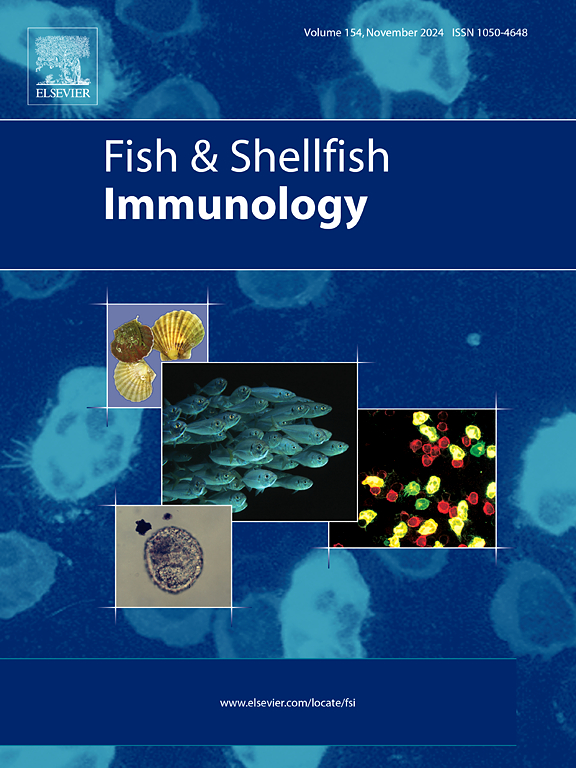Expression and antimicrobial characterization of rhamnose-binding lectin in Pinctada fucata martensii
IF 4.1
2区 农林科学
Q1 FISHERIES
引用次数: 0
Abstract
Rhamnose-binding lectins (RBLs) are key components of pattern recognition molecules involved in pathogen clearance during non-specific immune responses and play an important role in the immune response of Mollusca. Pinctada fucata martensii is an essential species for artificial seawater pearl cultivation in China. With the increasing pollution of seawater, the study of the immune function of P. f. martensii has become increasingly urgent. Therefore, investigating the basic structural characteristics and immunological activity of RBL is of significant interest. This study employed RACE technology to clone and perform bioinformatics analysis on the RBL from P. f. martensii (PmRBL). Real-time quantitative fluorescence (qRT-PCR) technology was used to analyze gene expression following stimulation with pathogen-associated molecular patterns (PAMPs). In addition, a prokaryotic expression vector for PmRBL was constructed, followed by an evaluation of the antibacterial and hemolytic activities of the recombinant protein. The results revealed that the cDNA sequence of the PmRBL gene is 1045 bp in length, with its open reading frame (ORF) encoding 212 amino acids that include two D-galactoside-binding lectin domains. The expression of PmRBL across various tissues and in response to PAMP stimulation showed that PmRBL was most abundantly expressed in the gill tissue of P. f. martensii and exhibited a significant response to stimulation with lipopolysaccharides (LPS). From the perspective of antibacterial activity, PmRBL exhibited significant efficacy against Gram-negative bacteria. Overall, this study enhances our understanding of the functional characteristics of RBLs in Mollusca and provides new insights into the immune molecular polymorphism of P. f. martensii.
鼠李糖结合凝集素在fucata martensii中的表达及抗菌特性。
鼠李糖结合凝集素(RBLs)是非特异性免疫应答中参与病原体清除的模式识别分子的关键成分,在软体动物的免疫应答中起着重要作用。fucata martensii是中国人工海水珍珠养殖的重要品种。随着海水污染的日益严重,对马氏p.f. martensii免疫功能的研究日益迫切。因此,研究RBL的基本结构特征和免疫活性具有重要意义。本研究采用RACE技术对马氏斑蝽RBL (PmRBL)进行克隆和生物信息学分析。采用实时定量荧光(qRT-PCR)技术分析病原体相关分子模式(pathogen associated molecular patterns, PAMPs)刺激后的基因表达。构建了PmRBL原核表达载体,并对重组蛋白的抗菌和溶血活性进行了评价。结果表明,PmRBL基因cDNA序列长1045 bp,其开放阅读框(ORF)编码212个氨基酸,包括两个d -半乳糖苷结合凝集素结构域。PmRBL在不同组织中的表达和对PAMP刺激的响应表明,PmRBL在马氏马氏p.f. martensii鳃组织中表达最丰富,并对脂多糖(LPS)刺激表现出显著的响应。从抗菌活性的角度来看,PmRBL对革兰氏阴性菌具有显著的抗菌作用。总的来说,本研究增强了我们对软体动物rbl功能特征的认识,并为马氏p.f. martensii的免疫分子多态性提供了新的见解。
本文章由计算机程序翻译,如有差异,请以英文原文为准。
求助全文
约1分钟内获得全文
求助全文
来源期刊

Fish & shellfish immunology
农林科学-海洋与淡水生物学
CiteScore
7.50
自引率
19.10%
发文量
750
审稿时长
68 days
期刊介绍:
Fish and Shellfish Immunology rapidly publishes high-quality, peer-refereed contributions in the expanding fields of fish and shellfish immunology. It presents studies on the basic mechanisms of both the specific and non-specific defense systems, the cells, tissues, and humoral factors involved, their dependence on environmental and intrinsic factors, response to pathogens, response to vaccination, and applied studies on the development of specific vaccines for use in the aquaculture industry.
 求助内容:
求助内容: 应助结果提醒方式:
应助结果提醒方式:


